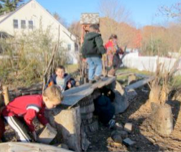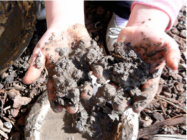
According to Richard Louv, author of Last Child in the Woods, children becoming more and more removed from nature, which is affecting their psychological and physical well being. Children today spend more time in structured activities and on electronic devices and less time engaged in unstructured play in nature. Louv shares many studies that show that spending time in nature has tremendous health benefits. Among these benefits are: increased fitness levels, improved concentration, reduced stress, as well as, improved vision. Studies also show that unstructured play in nature can help treat mental illness- particularly ADHD and depression. Children who spend more time in nature develop increased coordination- especially in balance and agility, inventiveness, improved intellectual development, and a greater ability to engage in creative play. Here are four simple ways to actively engage young children with nature…
Climbing Trees…

 Climbing trees is an excellent activity for gross motor development. It's great exercise, builds strength, and improves balance and coordination. When climbing, children use problem solving skills as they test branches to make sure they are safe and sturdy. They learn safety skills and are given the opportunity to take appropriate risk. Also, the tree itself offers a tactile and natural touch experience as children grip and hold onto the limbs as they climb.
Climbing trees is an excellent activity for gross motor development. It's great exercise, builds strength, and improves balance and coordination. When climbing, children use problem solving skills as they test branches to make sure they are safe and sturdy. They learn safety skills and are given the opportunity to take appropriate risk. Also, the tree itself offers a tactile and natural touch experience as children grip and hold onto the limbs as they climb.
Playing in a mud puddle…
 Playing in the mud is a fun sensory experience that can also help children learn and develop. As they maneuver through the mud, children strengthen their balance, visual scanning skills, and tactile (touch) senses. As they explore mud, children express their creativity, enhance their fine motor skills, and engage in pretend play that fosters language, science, and math learning. Mud can also act as an art medium that children can mold and decorate in unique and creative ways.
Playing in the mud is a fun sensory experience that can also help children learn and develop. As they maneuver through the mud, children strengthen their balance, visual scanning skills, and tactile (touch) senses. As they explore mud, children express their creativity, enhance their fine motor skills, and engage in pretend play that fosters language, science, and math learning. Mud can also act as an art medium that children can mold and decorate in unique and creative ways.
Walking barefoot…
 If we take children outside and let them go barefoot on natural surfaces and fallen trees, we enhance their sensory experience in so many different ways. They would get the opportunity to experience different textures and the chance to feel the sensations of moist vs. dry, crunchy vs. soft, noisy vs. quiet, as well as changes in temperature. Walking barefoot has also been associated with better balance, increase foot strength, decreased stress, increased blood circulation, and improved posture.
If we take children outside and let them go barefoot on natural surfaces and fallen trees, we enhance their sensory experience in so many different ways. They would get the opportunity to experience different textures and the chance to feel the sensations of moist vs. dry, crunchy vs. soft, noisy vs. quiet, as well as changes in temperature. Walking barefoot has also been associated with better balance, increase foot strength, decreased stress, increased blood circulation, and improved posture.
Building forts…
 Children love to create forts using everything from sticks and leaf covered branches to logs and wood planks. Outdoor fort building promotes inventive play that is essential for a child’s brain development. It allows young children to strengthen their problem solving skills, creativity, imagination, and planning skills. If working with others to build a fort, children develop teamwork, communication, and negotiation skills.
Children love to create forts using everything from sticks and leaf covered branches to logs and wood planks. Outdoor fort building promotes inventive play that is essential for a child’s brain development. It allows young children to strengthen their problem solving skills, creativity, imagination, and planning skills. If working with others to build a fort, children develop teamwork, communication, and negotiation skills.
 Nature is truly the ultimate learning experience for young children. It is time we step beyond the confining walls of our classroom and bring children’s learning back to nature. So, climb a tree, get dirty, take off your shoes, and build a fort. Children will have fun and learn a great deal while doing it! Live by the words of William Wordsworth and “let nature be your teacher.”
Nature is truly the ultimate learning experience for young children. It is time we step beyond the confining walls of our classroom and bring children’s learning back to nature. So, climb a tree, get dirty, take off your shoes, and build a fort. Children will have fun and learn a great deal while doing it! Live by the words of William Wordsworth and “let nature be your teacher.”
 Nature is truly the ultimate learning experience for young children. It is time we step beyond the confining walls of our classroom and bring children’s learning back to nature. So, climb a tree, get dirty, take off your shoes, and build a fort. Children will have fun and learn a great deal while doing it! Live by the words of William Wordsworth and “let nature be your teacher.”
Nature is truly the ultimate learning experience for young children. It is time we step beyond the confining walls of our classroom and bring children’s learning back to nature. So, climb a tree, get dirty, take off your shoes, and build a fort. Children will have fun and learn a great deal while doing it! Live by the words of William Wordsworth and “let nature be your teacher.”



Comments
Post a Comment
We invite you to share your thoughts and additional resources with our community of readers.
Also, contact us if you would like to be a guest blogger.